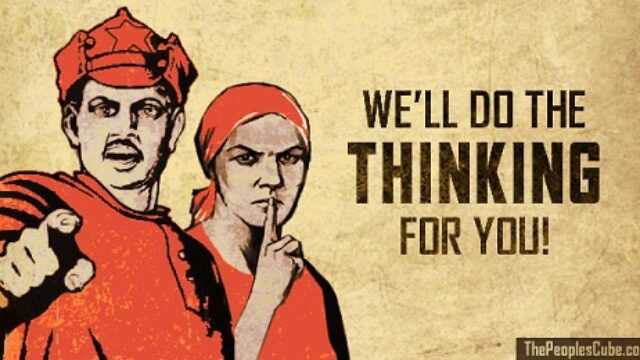Ten Years of Censorship That Was Censored

For a decade, conservative voices were erased by tech giants — yet the media now pretends censorship began only when comedians faced suspension.
For every conservative in America who is delighted that at least some of the purveyors of hate speech and misinformation on the woke left are at last being held accountable, there is another who still adheres to the ideals of free speech. As UFC CEO Dana White recently said on 60 Minutes, “Probably the most important speech to protect is hate speech.”
That diversity of opinion never surfaced among the left, however, over the nearly ten years during which alleged misinformation and hate speech were suppressed whenever they originated from conservatives. Whether they were hard right or just right-of-center but touching on forbidden topics and themes, they were shadow-banned, demonetized, deplatformed, and debanked. Almost nobody outside their circles of followers ever knew, and for people on the left who did know, they didn’t care.
To those of us who followed the systematic suppression of unapproved content, it seems incredible that anyone can believe our mainstream news sources, pundits, and journalists working for PBS, ABC, CBS, NBC, CNN, MSNBC, the New York Times, and others, who are now proclaiming we have entered an era of unprecedented authoritarian censorship. This is a brazen lie, but people believe it.
In a conversation last week with someone whose politics are centrist, perhaps slightly left-of-center, I was surprised to hear this lie regurgitated, verbatim. With genuine apprehension, if not terror, and presented to me as undeniable fact, was that President Trump and his minions have imposed government control over the media. Democracy is dead. God help us all. Etc.
What I quickly realized was that it would be futile to attempt to discuss this any further. The fact of the government pressuring corporations to censor content they didn’t approve of—most corporations enthusiastically complied and would have done it anyway—is something that took off after Trump’s unexpected victory in 2016 and didn’t even begin to slow down until Elon Musk purchased Twitter in October 2022.
All of this was well documented in February 2025 when investigative journalists Michael Shellenberger and Matt Taibbi (both former progressives) testified in a congressional hearing on what they dubbed “the censorship-industrial complex.” And we were there. We were watching.
In an attempt to document examples of censorship in 2019, in a “long form” article (this was way before Substack went mainstream) for American Greatness, “The Establishment War on the Intellectual Dark Web,” I documented many of the expulsions that had already happened since 2016. That article was premised as follows:
“Who are these censors? Not an oppressive government, but instead the private quasi-monopolies that control all online communication—the social media and video platforms, the providers of membership services, and the payment processors. Piss them off? Disappear into actual darkness.” That article also summarized—well before the 2022 defamation judgments—how Alex Jones had his voice crushed by censorship. It is a textbook case of what happened and can still happen.
After peaking at 125 million views in November 2016, Jones’s reach declined to 25 million views by July 2018, an 80 percent drop in 20 months. Even the industry journal Advertising Age acknowledged that Facebook, Twitter, and YouTube “clearly were trying to reduce his impact.” Then, for the first time, the major online platforms coordinated their efforts. Within a few days in early August 2018, Alex Jones’s “Infowars” was expelled from Apple Podcasts, Facebook, Spotify, and YouTube. On September 6th, Twitter followed suit. On September 8th, Apple banned Alex Jones’s InfoWars app from its App Store. Jones was virtually erased. He had 2.4 million YouTube subscribers, all gone; 830,000 Twitter followers, purged; his Apple podcast archives were deleted; and his Facebook page, with 2.5 million followers, was wiped out.
We can document what happened to Alex Jones, but meanwhile, smaller players were being dealt out of the conversation by the thousands. And it wasn’t just social media that got into the act of censorship.
The next level of suppression was the denial of membership services. If a content creator is expelled from one membership service platform, they cannot easily rebuild on another platform. If they have, for example, a half-million supporters on Patreon, and Patreon expels them, then every one of those half-million supporters has to open an account with the new membership services platform, and only then can they elect to resume supporting that content creator.
Censorship didn’t (and doesn’t) end there. A website can open up its own membership services portal by adding a page that accepts donations and hooking it up to a bank account. But the ultimate link in the chain is online payment processors, of which there are only two, PayPal and Stripe. And if payment processors stop processing their transactions, they are dead in the water.
In 2019, as examples of content censorship became increasingly numerous, I launched a website in collaboration with American Greatness to highlight content creators whose work was being suppressed. We built and maintained a database for a year, adding more than 400 profiles. We divided our records into five categories: Christian Patriot, Climate Skeptic, Free Speech Ally, Irreverent Investigator, and Western Warrior. From August 2020 through August 2021, we also posted a weekly report highlighting how ongoing censorship was being applied. Examples were plentiful.
Remember when Gab.com was launched? The founder not only had to build a social media platform. To monetize it, he had to start up his own bank. Remember Parler? What about Facebook’s snitch campaign launched in July 2021, encouraging members to turn in anyone posting “extremism?” Remember when LinkedIn deleted the account of the scientist who invented mRNA? How about when Facebook suspended President Trump in July 2021, alleging he posed “a danger to the public?”
Censorship in those days already extended into realms nobody typically thinks about. The video application JW Player, claiming “PragerU’s content is misleading” but providing no examples, canceled their user agreement. Prager had selected JW Player in order to host videos independent of YouTube’s platform. Oops. Speaking of YouTube, remember when, in March 2021, they banned Trump’s speech at CPAC? How’s that for coordinated censorship: banning a US president from Twitter, YouTube, and Facebook.
Back in 2021, Twitter was banning people faster than one could track. Notables included Bronze Age Mindset, Nick Fuentes, Project Veritas (and just for good measure, James O’Keefe), Rogan O’Handley, Way of the World, and, in one day, on February 7, 2021, Gateway Pundit’s Jim Hoft, radio host Wayne Allyn Root, and freedom activist Pamela Geller. Twitter banned Lin Wood’s #FightBack and Laura Loomer and took down a video from America’s Frontline Doctors.
Do we agree with everything that every one of these people has to say? No, of course not. We agree emphatically with some of the things that some of them say. Other utterances, here and there, we condemn. And we don’t agree as to which is which. But to repeat what Dana White famously just said, “Probably the most important speech to protect is hate speech.”
This is just a taste. Twitter erased thousands of accounts. So did Facebook. So did YouTube, again and again. The scope of censorship even reached WordPress, which deplatformed Conservative Treehouse. They built their website using WordPress, attracting up to 1 million visitors per day, and suddenly, voila, their WordPress engine stopped working. Where was David Muir? Where was Geoff Bennett?
The story of modern, technology-driven censorship goes on and on. What happened to Andy Ngo, a journalist of extraordinary integrity and courage, ought to show anyone who thinks Jimmy Kimmel’s temporary suspension is a novel harbinger of fascism everything needed to change their mind. Ngo was thrown off PayPal and Instagram and had his first book banned from the landmark independent bookstore, Powell’s, located in his hometown of Portland. For years, Ngo was maligned and physically attacked and has ultimately been driven into hiding. And yet PBS “news” reporters still preface any mention of his name with the stigmatizing adjective “far right.”
And so it goes. People plugged into right-of-center alternative sources of news and information, which by now is about half the nation, may not appreciate how much reach and credibility still rest in the hands of so-called mainstream media. Its mission is to omit any coverage of censorship prior to the incredible trauma suffered by two harmless, hapless, innocent, and vulnerable late night comedians at the hands of fascists. At the same time, they subject their viewers to ongoing conditioning—such that they can’t imagine anything remotely similar, let alone far worse, has ever happened before.
https://amgreatness.com/2025/10/01/ten-years-of-censorship-that-was-censored/
